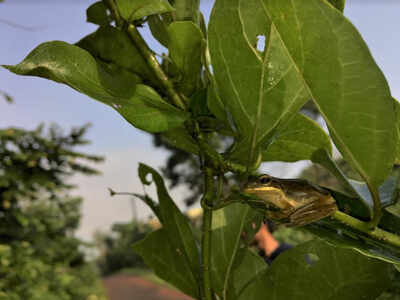
MANGALURU: A team of researchers have said that the south-western laterite plateaus of India are home to several lesser studied frog species. A study conducted by researchers Madhushri Mudke, Neelvara Aravind from Ashoka Trust for Research in Ecology and the Environment, Bengaluru, Dr K V Gururaja, from Srishti Institute of Art Design and Technology, Bengaluru and Ramit Singal, researcher currently based out in Australia are among the first to provide a comprehensive list of frogs from the lateritic plateaus.
The study also reports on the presence of malformations in frogs from this region.
Madhushri told TOI, "We have compiled a list of 19 species belonging to five different families, including notes on microhabitat structure and associated species during the surveys conducted between 2016 and 2018 in Manipal, a predominant lateritic landscape. Lateritic plateaus of India are geographically and ecologically complex plateaus that support endemic flora and fauna. However, despite their uniqueness they are termed as "wastelands”. The plateaus’ overall treeless structure makes them susceptible to developmental activities like infrastructure growth, waste dumping, and urbanization. The growing demands for urbanization, presence of malformed frogs, and habitat complexities highlight the need to re-evaluate our understanding towards these plateaus," she said.
The research paper released on CheckList- the journal of biodiversity data on Friday has stated that in India, 451 species of amphibian have so far been identified.The Western Ghats and the North Eastern Region are biodiversity hotspots, where major anuran (frog) were discovered. However, at least three new species of frogs in the last five years were discovered from lateritic plateaus. Lateritic plateaus are outside assigned Reserve Forest Areas and are not legally protected. Currently, waste dumping, laterite mining, infrastructure development, and landscape modification for aesthetic purposes are increasing throughout the plateaus. The plateaus not only support frog biodiversity but harbour other animal and plant biodiversity.
"The current status of wasteland does injustice to such a diverse and unique landscape. The preservation of areas of laterite plateaus for scientific studies is needed. This will give us important insights for determining conservation policies for frogs and other priority species, "she said.
Researchers involved citizen scientists, mostly students and teachers, from the Manipal Academy of Higher Education, Manipal, who helped to collect data collection. They organised leisure frog walks with children and students to instill the idea of citizen science.
Malformation in frogs
The study also found 10 malformed frogs. "We suspect that some of the malformations might be due to trauma. Malformations among frogs have been linked to anthropogenic disturbance and pollution, such as pesticides," said Madhushri Mudke.
The study also reports on the presence of malformations in frogs from this region.
Madhushri told TOI, "We have compiled a list of 19 species belonging to five different families, including notes on microhabitat structure and associated species during the surveys conducted between 2016 and 2018 in Manipal, a predominant lateritic landscape. Lateritic plateaus of India are geographically and ecologically complex plateaus that support endemic flora and fauna. However, despite their uniqueness they are termed as "wastelands”. The plateaus’ overall treeless structure makes them susceptible to developmental activities like infrastructure growth, waste dumping, and urbanization. The growing demands for urbanization, presence of malformed frogs, and habitat complexities highlight the need to re-evaluate our understanding towards these plateaus," she said.
The research paper released on CheckList- the journal of biodiversity data on Friday has stated that in India, 451 species of amphibian have so far been identified.The Western Ghats and the North Eastern Region are biodiversity hotspots, where major anuran (frog) were discovered. However, at least three new species of frogs in the last five years were discovered from lateritic plateaus. Lateritic plateaus are outside assigned Reserve Forest Areas and are not legally protected. Currently, waste dumping, laterite mining, infrastructure development, and landscape modification for aesthetic purposes are increasing throughout the plateaus. The plateaus not only support frog biodiversity but harbour other animal and plant biodiversity.
"The current status of wasteland does injustice to such a diverse and unique landscape. The preservation of areas of laterite plateaus for scientific studies is needed. This will give us important insights for determining conservation policies for frogs and other priority species, "she said.
Researchers involved citizen scientists, mostly students and teachers, from the Manipal Academy of Higher Education, Manipal, who helped to collect data collection. They organised leisure frog walks with children and students to instill the idea of citizen science.
Malformation in frogs
The study also found 10 malformed frogs. "We suspect that some of the malformations might be due to trauma. Malformations among frogs have been linked to anthropogenic disturbance and pollution, such as pesticides," said Madhushri Mudke.

Coronavirus outbreak
Trending Topics
LATEST VIDEOS
City
 Shocking Covid-19 lapse: Discarded PPE kits lying all over in Delhi's Lodhi crematorium
Shocking Covid-19 lapse: Discarded PPE kits lying all over in Delhi's Lodhi crematorium  Covid-19: Delhi surpasses Tamil Nadu, now second worst-hit
Covid-19: Delhi surpasses Tamil Nadu, now second worst-hit  Entire nation is delighted, Union Home Minister Amit Shah welcomes SC decision allowing Puri Rath Yatra
Entire nation is delighted, Union Home Minister Amit Shah welcomes SC decision allowing Puri Rath Yatra  Covid-19: DGCA specifies home quarantine rules for airline crew, amends circular
Covid-19: DGCA specifies home quarantine rules for airline crew, amends circular
More from TOI
Navbharat Times
Featured Today in Travel
Quick Links
Kerala Coronavirus Helpline NumberHaryana Coronavirus Helpline NumberUP Coronavirus Helpline NumberBareilly NewsBhopal NewsCoronavirus in DelhiCoronavirus in HyderabadCoronavirus in IndiaCoronavirus symptomsCoronavirusRajasthan Coronavirus Helpline NumberAditya ThackerayShiv SenaFire in MumbaiAP Coronavirus Helpline NumberArvind KejriwalJammu Kashmir Coronavirus Helpline NumberSrinagar encounter
Get the app



